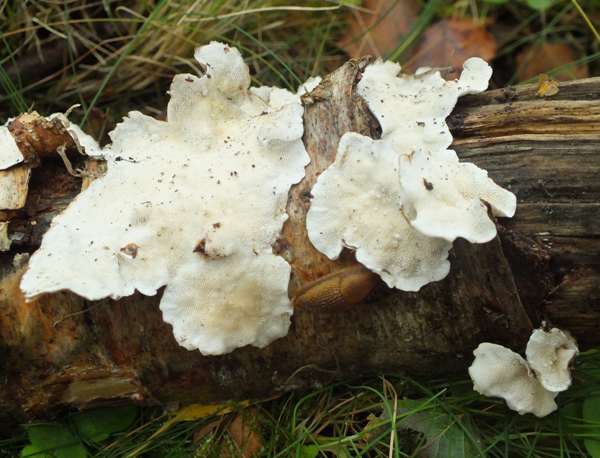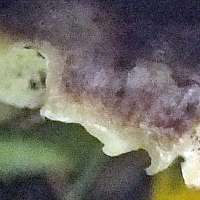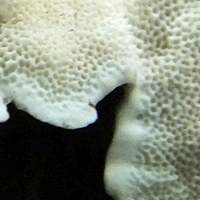Skeletocutis nivea (Jungh.) Keller - Hazel Bracket
Phylum: Basidiomycota - Class: Agaricomycetes - Order: Polyporales - Family: Polyporaceae
Distribution - Taxonomic History - Etymology - Identification - Culinary Notes - Reference Sources

Skeletocutis nivea is one of about 30 poroid species in this genus, and it is also one of the most distinctive; however, microscopic study is advisable if you are seeking an identification with absolute certainty. As with most other bracket and crust-like fungi, Hazel Bracket can be found well in to the winter months when most cap and stem fungi have been obliterated by frost.
Distribution
Hazel Bracket is widespread and common across most of Britain and Ireland, although records are rather sparse in West Wales and northern Scotland. This wood-rotting fungus occurs also throughout much of mainland Europe and in parts North America.
Taxonomic history
Hazel Bracket was described scientifically in 1839 by German mycologist Franz Wilhelm Junghuhn, who gave it the binomial scientific name Polyporus niveus. The currently-accepted scientific name Skeletocutis nivea dates from a 1979 publication in Persoonia by the Swiss mycologist Dr. Jean Keller.
Synonyms of Skeletocutis nivea include Incrustoporia nivea (Jungh.) Ryvarden, Incrustoporia semipileata (Peck) Domański, Tyromyces semipileatus (Peck.) Murrill, and Leptotrimitus semipileatus (Peck.) Pouz.
Etymology
The generic name Skeletocutis comes from Skeleto- meaning withered or dried up, and -cutis meaning a skin, while the specific epithet nivea means white, a reference to the colour of the fertile surface of this fungus.
Identification guide
 |
FruitbodyEither resupinate or forming oval patches or brackets (sometimes fusing together), individually 2 to 5cm across and when in bracket form up to 2cm thick. The upper surface is initially whitish, but older specimens may become brown or dark grey with a whitish margin; infertile surface initially downy or tomentose becoming smooth but with irregular warts and pits. The cork-like flesh is fairly soft and white or very pale brown. |
 |
Fertile surfaceWhite or cream, turning yellowish and bruising brown; all but the outer margin is covered in tubes, which are less than 2mm deep and terminate in tiny roundish pores spaced at 7 to 9 per mm. |
SporesCylindrical, smooth, slightly allantoid (sausage-shaped), 4-5 x 0.5-1µm; inamyloid. Spore printWhite. |
|
Odour/taste |
Not distinctive. |
Habitat & Ecological role |
Saprobic, on dead deciduous hardwood - notably fallen twigs of Haze or Ash - causing white rot. |
Season |
Seen throughout the year. |
Similar species |
Many similar species in this genus differ slightly in pore dimensions and in the microscopic features of their spores, basidia and hyphae. |
Culinary Notes
This polypore is far too insubstantial to be of any culinary interest.
Reference Sources
Keller, J. 1979. Ultrastructure des hyphes incrustées dans le genre Skeletocutis. Persoonia. 10(3):347-355
Pat O'Reilly (2016). Fascinated by Fungi, First Nature Publishing
BMS List of English Names for Fungi
Paul M. Kirk, Paul F. Cannon, David W. Minter and J. A. Stalpers. (2008). Dictionary of the Fungi; CABI.
Taxonomic history and synonym information on these pages is drawn from many sources but in particular from the British Mycological Society's GB Checklist of Fungi.
Fascinated by Fungi. Back by popular demand, Pat O'Reilly's best-selling 450-page hardback book is available now. The latest second edition was republished with a sparkling new cover design in September 2022 by Coch-y-Bonddu Books. Full details and copies are available from the publisher's online bookshop...

